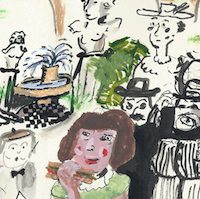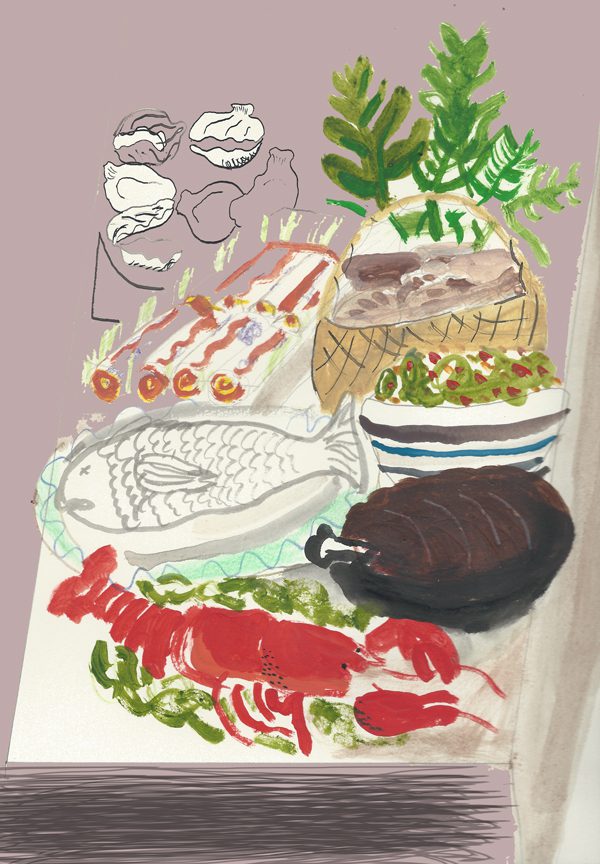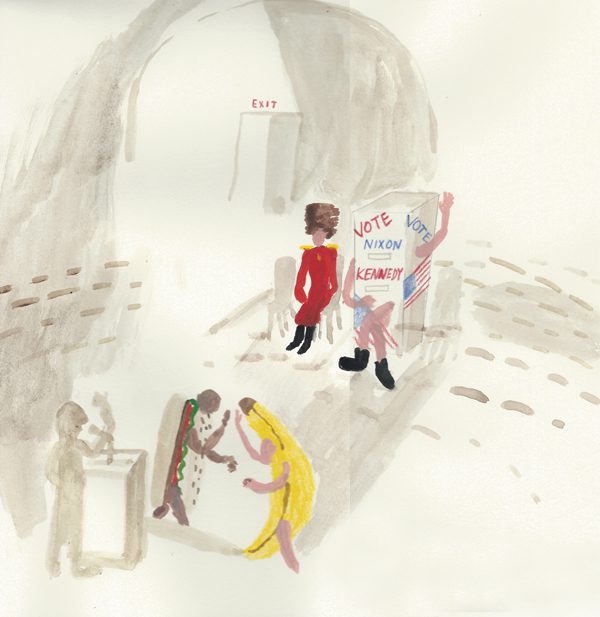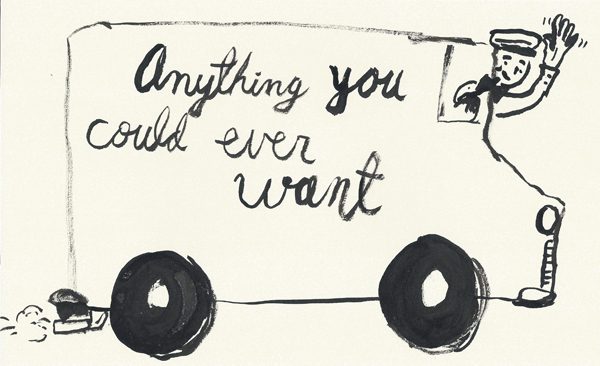“So which would you say is hotter: the shrimp balchow or the chicken vindaloo?” Our waiter just stares at me, then holds up a finger, says “One minute,” and walks back into the kitchen. I look across the table to see my wife and daughter glaring at me. What I want to say is that if I were eating with some fellow foodies, discussing the menu with the waiter would not just be acceptable—it would be required. But, of course, they could then point out that there is a difference between discussing and obsessing; that we’re not in a trendy, new Indian place in Williamsburg or Wicker Park; we’re in a tiny, shabby storefront restaurant in northern India; and that the waiter I was interrogating about whether the masala is heavier on cumin or turmeric can’t be older than thirteen.
While we wait for someone to emerge from the kitchen, my daughter, Emma, reminds me that that she has eaten at this restaurant many times before—she is here working for an organization that helps re-settle Tibetan refugees; we’re here to visit her—and that she can take care of ordering for all of us. She talks with the weariness of someone who has seen this before—and she has: this is definitely not the first time I’ve made a wait person wait while I tried to figure out the perfect order. And it’s not lost on me that while this can be irritating enough in some precious gastropub that charges $12 for shaved Brussels sprouts with shallots, it’s particularly unattractive, offensive even, in a country where so many go hungry. But I want to point out that I’m just excited about the food, that I’m just trying to order things we’ll all like, and that what happens to me in these moments has less to do with what’s in my head than what’s in my bones. While I’m defending myself to myself, a middle-aged man emerges from the kitchen.
“You have questions?” he asks, looking at me.
“No, no, we’re all set:” Emma says, before I can do more damage. “The tandoori platter—is it possible to have that with extra vegetables and no meat, please?”
The waiter responds with that characteristically Indian back and forth head motion that is somehow both a shake and a nod. “Yes, of course,” he responds, in heavily accented Hindi. “Here everything is possible.”
Emma thanks him and tells him that we’d also like rice, dal, and naan.
“Of course,” he responds, and begins to walk away.
“Excuse me,” I hear myself say, knowing I shouldn’t be saying anything, “Could we also get an order of the Bhagan Bharta? Or, wait, is there something else, some other specialty, that you’d recommend instead?”
Since the waiter doesn’t respond right away and since I know how much trouble I’m in already, I try to hurry. “OK, well, then we’ll just have one order of Bhagan Bharta and… let’s see… what about trying one of the other breads? Maybe the peshwari or the poori or maybe the…”
“Dad, we have enough food,” Emma interrupts. “Really. We’re fine.”
I think about the simple and delicious meal that my daughter’s friend, a Tibetan monk living alone and far from home, prepared for us the previous night on a hot plate in his tiny room, and I feel embarrassed that I can’t shake the feeling that the quality of time spent with family and friends is directly related to—and maybe even dependent on—the quality and quantity of the food we eat. I resolve to change, to de-emphasize food, to try to focus on just the simple necessities. But just as I start to embrace my new philosophy of non-attachment, our waiter walks past carrying a platter of samosas that looks so good I can barely resist stopping him to put in an order.
*
“I shouldn’t eat this,” my mother would say, “but I’ve been good all day and this is my very favorite food in the world.” Even as a kid, I knew there was something a little strange about the idea that an adult deserved a rich treat for being good, especially when that adult was a high blood-pressured diabetic who often had to take to bed for days after cooking and consuming one of her epic dinner-party meals. The other reason my mother’s decision to eat her “very favorite food in the world” gave me pause was that I heard her use that exact description just as she was about to take an enthusiastic bite of—and here you could fill in the blank with literally dozens of choices—filet mignon, steak tartare, sweetbreads, leg of lamb with mint jelly, Lobster Newburgh, a BLT, a hot fudge sundae, Profiteroles au Chocolat, sacher torte, Baked Alaska, buttered popcorn.
All the same, I sensed early on that it made no sense to get moralistic or puritanical about what my mother ate or cooked since there were few other activities—at least for our family—that could produce anywhere near as much pleasure and good feeling. In an era well before nouvelle cuisine, Atkins, or South Beach, my mother loved food that you could not only die from but also die for. Like a lot of other suburban families in the 50s, we ate our share of satisfying, fat- and carb-intensive comfort foods: bacon and eggs and hashed browns for breakfast, grilled cheese for lunch, sirloin steak or roast beef with baked potatoes covered in butter and sour cream for dinner. But unlike most other suburban families in the 50s, my mother was just as likely to serve Cornish game hen with wild rice; South African lobster tails with individual bowls of melted butter; marinated, grilled flank steak with grilled corn on the cob that you could rotate in your individual corn-on-the-cob-shaped butter dish by turning the little plastic holders stuck into either end.
But what really distinguished my mother’s cooking from the cooking of our relatives, friends, and neighbors was her passion for what was then called “ethnic food.” As Jews, we had our predictable share of bagels and lox, brisket and kugel, matzah ball soup and gefilte fish. But my mother’s regular repertoire also included pasta carbonara, turkey tetrazzini, beef bourguignon, beef stroganoff, Moroccan-style chicken with couscous, Peking duck, shrimp curry, cheese fondue, Peruvian ceviche, and paella, which she always served with gazpacho and pitchers of ice-cold sangria. Of course, it wouldn’t be all that unusual to find someone cooking these foods today but in an era when lasagna and chow mein were on the outer edge of exotic for most middle-class Americans, the creativity and sophistication of my mother’s cuisine stood out. So did her lack of pretentiousness about food: she may have collected and read cookbooks like they were dime novels and dragged us all over the city in search of the best new Greek taverna or Korean Barbeque joint but there was nothing the least bit fussy or snobby about her cooking or eating.
It’s not that she was uncritical or undiscriminating. It’s just that she loved all sorts of things that a food snob might avoid, from perfectly melded and melted s’mores to street-vendored kosher hot dogs with sauerkraut and dill pickles. Not only can’t I remember a single food that made her squeamish, I can’t even remember—and this seems remarkable to me—a single food she hated or refused to eat. While not every single food made her very-favorite-in-the-world list, even the simplest tastes—a long swallow of a glass of ice water with lemon or a loud, crunching bite of a raw carrot—seemed to produce more pleasure than you’d ever imagine possible.
*
When Shirley Temple was seven, she met my mother, who was six. I suppose most people would describe that meeting in the opposite way, as an ordinary little girl who got to meet a celebrity, not as a celebrity who got to meet an ordinary little girl. But as my grandmother always told the story, it was a meeting of two great stars. It occurred in the mid-1930s when Temple, on a publicity tour for her latest movie, was greeting fans on a busy street corner in downtown Chicago. My mother happened to be there because every Saturday my grandmother would bring her first to her morning acting class and then to the Walnut Room in Marshall Fields to eat her very favorite sandwich, a “Fields Special”: turkey, bacon, Swiss, tomato, hard-boiled egg, and Thousand Island dressing on Jewish rye. My mother happened to be in the first row of the crowd because my grandmother, on spotting Temple, had managed to push right to the front. At which point, the movie star looked at my mother, walked over, and said, “Hi; I’m Shirley Temple. Would you like my autograph?”
“Hi, I’m Uni Millstone,” my mother responded. “Would you like my autograph?”
My grandmother believed that story showed that my mother was precociously adorable and brilliant, something she continued to believe to the day my mother died; I thought the story showed that my mother and grandmother were both a little nuts. I’ll admit that there is some pleasure in hearing a story in which a cutesy, spoiled, and precious little movie star gets some comeuppance, but I can’t help but think that my mother comes across as just as cutesy, spoiled, and precious, not to mention a little delusional. A seven-year-old who acts like a world-famous movie star is pretty hard to take, even if she is one; a seven-year-old who isn’t a world-famous movie star but is treated like one by her mother is headed for trouble.
*
My mother died suddenly at a dining room table, in the middle of a wonderful meal, surrounded by a large, extended family that loved her. One minute she was completely immersed in the world—talking, laughing, eating—and the next minute she was gone. Viewed from a distance, her death seems fitting for someone who so much loved family, food, and conversation but, in fact, everything was off. It wasn’t her table, it wasn’t her meal, and it wasn’t her family (she and my father were visiting friends in California when it happened). Most of all, it wasn’t her time: she was just 62, an age that gets younger every day.
*
It’s the school Halloween party, 1960. I am sitting in the middle of the auditorium with my brother, Joe. The principal is standing on one side of the stage, announcing into a microphone, “OK, now I want anyone dressed like some kind of food to come up on stage.” He peers out into the audience. “Over there, I see a banana… and a cheeseburger right in front. Come on up.” The banana and burger looked excited to finally be recognized and relieved to know that they could leave the remaining misfits in the audience and rush onto the stage now crowded with genres already called: ghosts and goblins, angels and fairies, witches and devils, princes and princesses, pirates, monsters, ballerinas, athletes of one sport or another, animals, dinosaurs, clowns, soldiers, super heroes, firemen and policemen (this was an era before gender-neutral job titles), doctors and nurses.
Since Joe and I are now the only ones left, the principal has a chance to study our costumes, but it is clear from the look on his face that he still has no clue what category either of us belongs to. It’s not his fault—my mother has dressed me as a Russian Cossack with a huge fur hat, a long, red military coat, and a droopy mustache (an odd costume considering my Russian Jewish grandparents had to flee their homes to escape the pogroms). And she has convinced Joe to go out trick or treating as a voting booth. “You tell the people they can drop the candy into the slot of the candidate they want—either the Kennedy slot or the Nixon slot. You tell them that you’ll count up the candy at the end and announce who won. That way, if someone really wants to vote for their favorite, they might give you more than one piece.”
*
“I don’t care about money; I just want to have enough to never have to think about it.” That was another thing my mother always said. As I kid, I admired and envied this attitude since it seemed so evolved, relaxed, un-neurotic. She didn’t seem especially status-conscious, hardly ever talked about a possession in terms of its economic value, wasn’t the least bit miserly. In fact, she was almost absurdly extravagant in the gifts she gave family and friends and even more extravagant in the things she bought for herself. If something caught her eye—an expensive cut of sirloin to use in a stew she planned to cook that night, an antique music box, an odd-shaped purple pillow with a painting of Virginia Woolf’s face on the front, a $300 carved wooden rocking horse for her granddaughter, a plane ticket to Hawaii to visit her sister—she bought it on the spot, without apparent hesitation or guilt. Of course, what I didn’t understand until I was older was that having enough money to never have to think about money was a luxury reserved only for people who were monastic, rich, or financially irresponsible. My mother would have said that she was none of those things (though I suspect an impartial observer would have convicted her on the last two charges and laughed at the first); she would have said—and on this she may have been right—that money didn’t matter to her except in the ways that it could produce happiness and pleasure for herself and the people she loved.
She brought a version of this same philosophy to food and cooking. She seemed to believe that at every meal there should always be enough different foods and courses that no one could possibly be disappointed and that there should always be enough of each individual dish that no one could ever worry about anything running out. I suppose that’s part of the reason that dinners at my house were almost always multi-coursed and multicultural. It wasn’t just the Paul Bunyan-like scale of the meals that got your attention; it was also the unbounded, almost fearless, imagination my mother brought to every food-related activity, from shopping to cooking to entertaining. She was the sort of cook who would come home with more than a dozen huge salmon fillets she intended to poach for a dinner, find that there were far too many to do all at once in her fish poacher, and decide that she’d poach them instead in the dishwasher (minus the detergent); the sort who would return from a vacation in Amsterdam with a suitcase full of teak serving bowls and platters that she then immediately put to use in recreating the 24-item Indonesian Rijstafel she had just discovered to be “her very favorite meal in the world”; the sort (if you could even call this a sort) who had an epiphany one evening while eating a toasted almond bar from a roadside Good Humor truck that it would be wonderful to be able to eat toasted almond bars, rainbow-colored popsicles, and ice cream sandwiches whenever we pleased and who, therefore, immediately made an under-the-table, against-company-policy arrangement with that same roadside Good Humor man to drive to our house very late one night each week to deposit boxes and boxes of ice cream bars into our restaurant-sized basement freezer, beside the hand-cut T-bone and Delmonico steaks she had mail-ordered in from a slaughterhouse in Kansas City.
*
My mother also produced and consumed words all day long. In the morning she would lounge on her bed, sipping strong black coffee and gulping down ice water, munching on a croissant, or, if she was being virtuous that day, a cream cheese-less bialy, talking on the phone, doing a crossword puzzle, reading a “junky bestseller,” re-reading a Jane Austen novel, half-watching and occasionally calling out the answers to a TV quiz show, and writing her own witty song lyrics to old Broadway melodies. For lunch, she’d often meet up with friends at a restaurant to gossip, tease, argue or joke about politics, commiserate about problems with husbands and kids. At the dinner table, surrounded by heaping piles and platters of foods, she’d orchestrate the conversation, asking questions, drawing us all out, forcing us to talk about what we thought or felt. Even when she wasn’t talking, she was still the center of attention, leaning forward, taking in every word, listening with a hunger that changed the energy in the room.
*
My wife and I go through phases when we never prepare or sit down to real meals, when we subsist on snacks of peanut butter, carrots, apples, cold cereal, and toast, when we begin to think of making oatmeal or tuna salad as cooking. On the other hand, when our daughters are visiting or when we have people over, I can spend hours planning menus, shopping, and cooking. In fact, when it comes to entertaining, I’ve inherited my mother’s style; in other words, I’m all about overkill. A dinner of grilled salmon doesn’t feel complete to me unless I make a couple of different sweet and spicy fruit salsas to accompany it. When my daughter was home on a recent visit and said she felt like having ziti or gnocchi, I made both, one with a marinara sauce, the other with pesto. And garlic bread and antipasto and salad and a marinated grilled shrimp appetizer. On some rational level, I know that it’s is all too much, but for some reason each individual item I consider cutting suddenly seems absolutely essential, not just to the meal but to the success of the entire evening.
*
I used to blame my mother for what she was doing to herself and, since we would be ones who would suffer without her, what she was doing to us. I used to be angry that, even after the heart failures, heart surgeries, and heart attacks, she kept eating rich foods. I even used to get vindictive sometimes and think that, like the grasshopper who was too selfish or undisciplined to plan for the future, she had brought all of this on herself. But now I wonder if maybe, given her genes and her temperament, she couldn’t have lived any other way. Maybe she knew that there was no amount of caution or sacrifice that could have kept her alive. Maybe she knew that doctors and scientists and nutritionists didn’t really know everything about the relationship between food and health, that the theories about red meats and red wines, white starches and saturated fats, were just theories, designed to give people the illusion of control, or to give corporations new ways to market their products. Or maybe she just did the calculations and asked herself: “Should I give up one of the few things that I know gives me the most pleasure and satisfaction in exchange for the outside chance that I will live maybe two or five or ten more years?” Did she stop each time to do the math or did she just close her eyes and bite the bullet?
*
While we are waiting for our check, Emma scoops up our leftovers and dashes out of the restaurant ahead of us. When I get on the street, I feel the sting of cold air—the temperature must have dropped 20 degrees since we began eating. It’s almost completely dark now and, for a second, I can’t find Emma. But then I hear her and see her, just across the street, leaning over, talking with a woman who is wrapped in a blanket with a baby in her lap and a toddler asleep by her side. My daughter hands our leftovers to the woman, who nods tight-lipped in appreciation, then tucks the food away behind her.
Standing on this cold, dark street, I suddenly feel overwhelmingly homesick and lost. I wish I could go back to that moment when the waiter was at our table and order only what we needed. I wish I could go back and order even more so I’d have food now to give to all the people in this city who are sleeping on the street. I wish I could call my mom. I wish I hadn’t inherited her feeling that you only have enough when you have too much.
*
Not long before she died, my mother threw a party in honor of my brother’s marriage. She was by that point so weak that she rarely cooked; in fact, she was so weak she often spent whole weeks in bed, eating her food on a tray. But for the party, she rallied. In honor of my new sister-in-law from Buenos Aries, the meal had an Argentinean theme: there were oysters sautéed with tomato, bacon, cream, ginger, coriander, and chili; there were platters of grilled, rare, marinated meats, including short ribs, flank steak, chorizo, and sweetbreads; there were giant bowls of chimichurri brimming with fragrant cilantro, garlic, vinegar, and oil; there were loaves and loaves of hot, crusty French bread; there was a huge paella-like casserole filled with yellow rice, shrimp, and sausage; there were beefcake tomatoes and red onions drizzled with in a red wine vinaigrette; and there were cases of Argentinean Malbecs and Spanish Grenaches. After all that, the simple, cinnamon-infused chocolate layer cake almost seemed a letdown until my mother announced that the rest of the dessert, the “real dessert,” was outside: “It’ll be a kind of ‘open bar,’” she explained. “Everybody will get to choose whatever they’d like… and as much as they’d like.” And with that, she lead us all out into the driveway where a Good Humor man in his starched white outfit and cap stood besides his truck, ready to give us anything we wanted.
***
Rumpus original art by Liam Golden.










3 responses
Another great piece, Lad, moving and rich in detail. It makes me hungry, afraid and guilty of indulging, and it makes me wish I knew your mom. Particularly loved the sad line about 62 getting “younger every day”; but I still think quality has to matter at least as much as quantity. But even as I say that, I feel the tension of the debate that’s so consistently and subtly flowing through your entire essay.
Thanks so much, John, for those generous comments about my essay. I especially appreciate them since I know how thoughtfully and movingly you’ve written about family relationships in “Only the Young Would Never Arrive.”
I love the way this essay moves between the concrete and the abstract, the present and the past, the ordinary and the heartbreaking. It gets at the way that we bring ourselves wholly and complexly to our everyday lives; we inhabit them in an immediate way that is simultaneously quotidian and profoundly resonant. Food here becomes a way of getting at family, subjectivity, class, ethnicity, guilt, privilege, and emotion. I consumed it all, with immense satisfaction.
Click here to subscribe today and leave your comment.